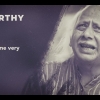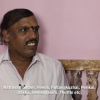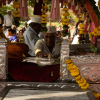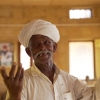The role of storytellers in transmitting tales and epics orally is crucial, but has been fading from public memory in recent times. Bards travelling from place to place singing tales and epics transmitted these stories but also preserved them in ways and forms that were often unique to their community. What is the relationship of orally known and transmitted tales to particular communities? And what happens when this link is sutured and tales float free outside communities that owned them?
In many ways the epic of Bharthari belongs to the community of Nath Panthis for the eponymous protagonist of this tale was the first disciple Gorakhnath, the main preceptor of the Nath sampradaya. Nath Jogis wandered from place to place propagating their faith, relating this tale and others including the tale of Gopi Chanda also known in this region. By all accounts the story of Bharthari was transmitted in Chhatttisgarh originally by them. For many in Chhattsigarh, hearing this story recited by wandering Nath Jogis was a regular feature. They came from outside the region, related their tales while seeking alms and went away, but the stories they told circulated amongst those who heard them and became part of the lore of this region.
Post -Independence the rise of professional artists in this region created the need for performing genres. The tale of Bharthari became one of these. And that in turn necessitated the need for a written version of the tale that could offer a stitched account of the narrative which was earlier known and related mostly in an episodic manner.
Jogi and professional storytellers: telling differences
The story of Bharthari is about renouncing the world to become a Jogi. There are several versions of this story in circulation across Northern India. Within Chhattisgarh, a comparison between a version sung by the Nath Jogis sung by Balak Das Jogi, and by Rekha Jalkshatri, a professional performing artist specializing in this genre, points to telling shifts in the emotional terrain of the story and its causality. Balak Das Jogi offers a telling of the story that is unmediated by written translations and connects to a lived understanding of the tale and its characters. Rekha Jalkshatri on the other hand offers a performative rendition of the tale, dramatized and embellished with Chhattisgarhi songs. Her narrative is a based on a written version of the story published by a press in Kolkata. The epic of Bharthari was first printed by the Gita press located in Gorakhpur, the main seat of the Nath Jogis in north India. It is possible that its source was the oral rendition of this tale by the Jogis.
The story told by Balak Das Jogi and Rekha Jalkshatri
According to the Jogi version the story begins when the young prince Bharthari is spotted by barbers and pundits from the court of Singhaldeep (Sri Lanka) who come looking for a suitable groom for their princess. He alone bears the lakshana of a Chakravartin and seems a desirable match for the princess. They approach Bharthari’s mother for her son’s hand in marriage. She responds saying that her son is destined to become a yogi when he turns eleven- a warning that does not deter the bride’s family and the marriage takes place. On the wedding day as Bharthari approaches his newly wedded wife she bursts into laughter and laughs so hard that the cot breaks. Bharthari asks her the reason and threatens to kill her if she doesn’t doesn’t answer. She responds by saying that her sister who was married to the ruler in Delhi would unlock the secret. At last Bharthari is invited to Delhi when his wife’s sister gives birth to a son. He plans to go to Delhi with a large army to intimidate her. She in turn prays to Shiva for help – he gives her a mere lump of rice which multiplies many times over to feed the entire army. When at last he meets her and demands to know the reason for his wife’s laughter (and his humiliation) she asks him if he would like to see it, or hear it. Bharthari responds by saying he wants to see the cause, and by implication witness it. In order to make him see and witness the cause, the sister takes birth several times- the last of these rebirths is as a young girl who marries the same boy who she gave birth to in the beginning of the tale. This was a sin, expiated by the fact that several re births had elapsed in between. This is the kernel of the story, the explanation that Bharthari had sought in the first place. His wife was his mother in his previous birth but this sin was not expiable. His wife’s sister had taken several births in order to make Bharthari witness and see the truth he was seeking. For Bharthari this sin is of staggering proportions. He is mortified and aghast. How can he redeem himself? His wife’s sister suggests two paths – that of yog or bhog. Bharthari chooses the former, the path of yog or renunciation. How would he get diksha? He resolves to kill a black buck and seek diksha from the yogi who restores its life. As the plan unfolds, it is Guru Gorakhnath who brings the black buck back to life and makes him his disciple. A condition must be met with before, however- he must accept alms from his wife in order to of worldly fetters. This done, raja Bharthari becomes a jogi.
Rekha Jalkshatri’s version of the story of privileges emotion and pathos over causality and fate. The thread that draws the Nath Jogi version together gives Bharthari’s wife’s sister a key role in interpreting the dilemma and showing the path to renunciation. She embodies it in a sense through reincarnations that reveal the tragic truth. This is missing in Rekha Jalkshatris narrative which heightens sentiment but does not effect an interior understanding of its causality. The narrative begins with the plight of Bharthari’s mother who is distraught at being childless. She finally gives birth to a son through the blessings of a Nath yogi who offers her a fruit with powers to help her conceive. At his birth astrologers were called from Benaras to cast his horoscope. The astrologers predict that the child would renounce the world to become an ascetic after the age of twelve. The mother, dismayed, approaches soothsayers and yogis for a solution that could alter his fate, but to no avail. She therefore resolves to marry him off at a young age to prevent him this. On his wedding night Bharthari goes to his wife seated on a golden cot. When he approaches her, his wife bursts into laughter and breaks the cot. Bharthari is perplexed and humiliated. Why did she laugh so hard on seeing him that she broke the cot? What was the reason for her amusement? She refuses to divulge the cause, answering instead that her sister who lived in Delhi would provide the answer, not she. Bharthari waits for a pretext to travel to Delhi. Finally, his sister-in-law gives birth to a child, and Bharthari is invited to be part of the celebrations. His wife advises him to travel in full princely regalia, for her sister was married to the ruler of Delhi. When he finally meets his sister-in-law, Bharthari asks her why his wife had laughed at him on their wedding night. She defers disclosure, and says she will disclose on her rebirth as a pig, and then as a hen and so on for seven lives as dog, parrot, and other fabulous lives. She finally discloses that his wife was, in fact, his mother in his previous birth; this memory made her break into laughter. The revelation causes Bharthari great consternation. The story shifts to the scene of a hunt: Bharthari is off in pursuit of a magical deer. He encounters its spouse who offers her own life and begs him to spare that of her mate. Bharthari, driven by ideals of his caste, refuses and hunts down the deer. A curse is on him now, for this killing. The Nath yogi staves off the curse on Bharthari by restoring the deer to life. Bharthari is moved by a desire to renounce the world and become the disciple of the Nath yogi, Guru Gorakhnath himself. The yogi warns him that the path is not easy—he has to cut off ties with his wife, approach her as a mendicant, call her mother and receive alms. This is not easy. His wife refuses at first but has to give in eventually. Bharthari becomes a Nath yogi.
In many ways the difference between the two versions is a pointer to what is lost and gained when stories move out of communities that own them to become part of a professional storytelling world: its inner meaning and rationale are lost and wider connections forged.
This content has been created as part of a project commissioned by the Directorate of Culture and Archaeology, Governrnent of Chhattisgarh, to document the cultural and natural heritage of the state of Chhattisgarh
|
ReplyForward
|











